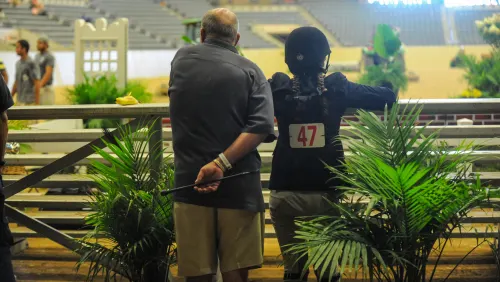 After the American Horse Council leaders published their new economic-impact study last week (see p. 40), I called Jay Hickey, the group’s president, and asked him what struck him most about it. Interestingly, it was the same thing that occurred to me–that it puts all of the sports we Americans do with horses into a context, into perspective.
After the American Horse Council leaders published their new economic-impact study last week (see p. 40), I called Jay Hickey, the group’s president, and asked him what struck him most about it. Interestingly, it was the same thing that occurred to me–that it puts all of the sports we Americans do with horses into a context, into perspective.
“It’s agriculture, sport, entertainment, gambling, recreation and exercise, with the horse as the common denominator. This will have people saying, ‘My gosh, I didn’t realize that,’ ” Hickey told me.
No matter what sport we do with our horses, we all think that it’s the biggest or most important. Spectators, prize money and million-dollar horses tend to convince flat-racing folks of their sport’s No. 1 status, and the AHC’s two previous studies tended to confirm their belief. Those surveys (in 1987 and 1996) were racing heavy since the sport just plain had the best and most easily attainable numbers. But this study is far more rigorous and inclusive, and it shows that the number of horses who race is roughly one-third of those involved in all other non-racing equine sports–and together they fall well short of the number of horses Americans ride for recreation.
Of course, everyone involved in the three Olympic disciplines tend to think that, among all those non-racing sports, theirs are the biggest and most important. The four-year Olympic media cycle contributes to that belief, as does the undoubted economic impact of the numerous show circuits and of major events like the Rolex Kentucky CCI or the World Cup Final, where many of the horses sell for six or seven figures. But this study reminds us that, in real numbers, the Olympic disciplines are a tiny fraction. (The U.S. Equestrian Federation–which includes far more than the Olympic disciplines–has 80,000-plus members, one-quarter of the American Quarter Horse Association’s 353,000 members.)
ADVERTISEMENT
Similarly, the study demonstrates the impact of the breeding industry, an area that we participants in non-racing horse sports often overlook. That’s understandable, in a way, because there’s usually such a long lag time between when a horse is conceived and when he competes, let alone becomes accomplished. But one of the key bits of information the AHC’s study contains is numbers proving that breeding is actually an agri-business, because facts like that can be used politically to preserve meadows and pastures in the face of the sprawling megalopolises attempting to overrun our country. In the days following the study’s release, both The Washington Post and the San Antonio (Texas) Express News ran stories about horses’ local impact. In Texas, horse farms have been replacing cattle ranches since the ’70s and increasing real estate values. And in Montgomery County, Md., just northwest of Washington, D.C., about 2,600 horse farms or stables populate the county’s 93,000-acre agricultural preserve, contributing $196 million annually to the county’s economy.
As I dug through the report’s data, perhaps most fascinating was the chart showing horse owners’ income levels. Our sports are often–justifiably–criticized for the cost of everything, and we participants are frequently characterized as nothing but America’s rich and famous. Well, the numbers show that the bulk of us horse owners are decidedly middle class. One-third makes less than $50,000 a year, and the largest single percentage (22.29%) has an income of $50,000 to $75,000. All told, 55 percent make less than $75,000, and 71 percent report incomes below $100,000.
We’ve always known we horse owners have a passion for equines that far exceeds our ability to pay for them, and I guess this study proves it.














